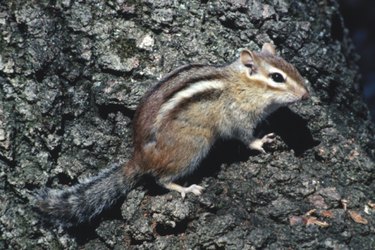
If you pay close attention to your lawn and potted plants, you may notice holes appearing seemingly by magic at different times of the year. Determining what is making holes in your lawn can feel bewildering, but if you approach the problem with scientific curiosity and a resolve to see it through, you can identify your invading lawn pests and learn how they can be deterred, trapped or killed.
What Has Been Making Holes?
Video of the Day
It can be hard to know which animal has been making holes in your yard. These holes can be perfectly round, lacking any mound around them or perhaps a wide and deep cone dug out from your turf or even 1 inch or so across and several inches deep with a little spray of dirt on one side. Depending on the particulars, these holes can be an indication of a major problem or merely a seasonal pest.
Video of the Day
Smaller holes may be the work of wasps or beetles. Some wasps burrow into the earth to find grubs to kill and to lay eggs, while other wasps may bury their egg-laden prey, like cicada killer wasps do. Japanese rose beetles also leave small holes with a little dirt piled to one side as they burrow down to lay their eggs at the end of summer.
Large Hole Culprits
As the size of the hole increases, so too does the size of the pest who made it. Moles make larger holes than voles, crayfish, wasps or beetles. They tend to pile up earth outside their hole (as high as 2 feet) in a volcano-shaped pile surrounding the caldera of the tunnel's entrance. Some small rodents, such as chipmunks, can actually cause damage to your house, so it's best to diagnose the creature and get rid of it quickly.
You may also have creatures such as armadillos, skunks or raccoons. These creatures make a cone-shaped excavation around the central point in which they were digging for grubs and worms. It's not unusual to see disturbed earth as deep as 5 inches and as wide as 10 inches across because of these pests.
Getting Rid of Pests
There are a variety of deterrents available for purchase; however, there are some baits that will have more success with garden pests if you decide to trap instead of deterring.
It's generally better to trap or deter than to kill larger garden pests, as the bodies can attract other more dangerous pests and predators if they aren't found and removed quickly. Generally, it's best to trap and release animals instead of killing them, as many other methods are considered to be inhumane. Contact your local wildlife or animal control helpline for specific advice for your area.
Live Traps for Pests
Even supposedly humane live traps can become inhumane if they are neglected. Glue traps, for example, are a low-cost and low-effort means of trapping animals but don't immediately kill the animals that are caught in them. If you don't constantly monitor them, the trapped animals panic and get further entangled, resulting in increased distress and pain.
If left unmonitored for long periods of time, the trapped animals can die gruesomely of starvation or dehydration. If you have doubts about how to handle garden pests, a pest control company should offer consultations for free.